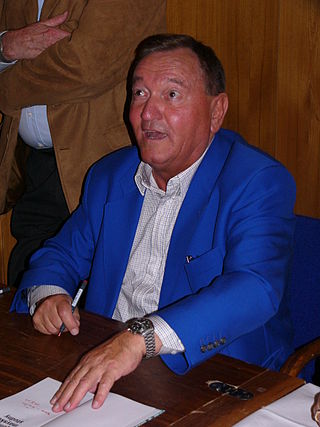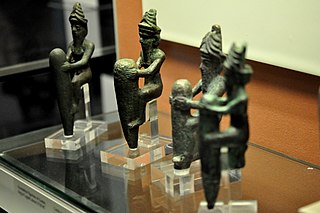Related Research Articles

Atlantis is a fictional island mentioned in Plato's works Timaeus and Critias as part of an allegory on the hubris of nations. In the story, Atlantis is described as a naval empire that ruled all Western parts of the known world, making it the literary counter-image of the Achaemenid Empire. After an ill-fated attempt to conquer "Ancient Athens," Atlantis falls out of favor with the deities and submerges into the Atlantic Ocean. Since Plato describes Athens as resembling his ideal state in the Republic, the Atlantis story is meant to bear witness to the superiority of his concept of a state.
Zecharia Sitchin was an author of a number of books proposing an explanation for human origins involving ancient astronauts. Sitchin attributed the creation of the ancient Sumerian culture to the Anunnaki, which he stated was a race of extraterrestrials from a planet beyond Neptune called Nibiru. He asserted that Sumerian mythology suggests that this hypothetical planet of Nibiru is in an elongated, 3,600-year-long elliptical orbit around the Sun. Sitchin's books have sold millions of copies worldwide and have been translated into more than 25 languages.

Erich Anton Paul von Däniken is a Swiss author of several books which make claims about extraterrestrial influences on early human culture, including the best-selling Chariots of the Gods?, published in 1968. Von Däniken is one of the main figures responsible for popularizing the "paleo-contact" and ancient astronauts hypotheses.
Pseudoarchaeology—also known as alternative archaeology, fringe archaeology, fantastic archaeology, cult archaeology, and spooky archaeology—is the interpretation of the past by people who are not professional archaeologists and who reject or ignore the accepted data gathering and analytical methods of the discipline. These pseudoscientific interpretations involve the use of artifacts, sites or materials to construct scientifically insubstantial theories to strengthen the pseudoarchaeologists' claims. Methods include exaggeration of evidence, dramatic or romanticized conclusions, use of fallacious arguments, and fabrication of evidence.

Ancient astronauts refer to a pseudoscientific set of beliefs which holds that intelligent extraterrestrial beings visited Earth and made contact with humans in antiquity and prehistoric times. Proponents suggest that this contact influenced the development of modern cultures, technologies, religions, and human biology. A common position is that deities from most, if not all, religions are extraterrestrial in origin, and that advanced technologies brought to Earth by ancient astronauts were interpreted as evidence of divine status by early humans.

The Anunnaki are a group of deities of the ancient Sumerians, Akkadians, Assyrians and Babylonians. In the earliest Sumerian writings about them, which come from the Post-Akkadian period, the Anunnaki are deities in the pantheon, descendants of An and Ki, the god of the heavens and the goddess of earth, and their primary function was to decree the fates of humanity. They should not be confused with the Apkallu.

Graham Bruce Hancock is a British writer who promotes pseudoscientific theories involving ancient civilizations and hypothetical lost lands. Hancock speculates that an advanced ice age civilization was destroyed in a cataclysm, but that its survivors passed on their knowledge to hunter-gatherers, giving rise to the earliest known civilizations of ancient Egypt, Mesopotamia, and Mesoamerica.

A flood myth or a deluge myth is a myth in which a great flood, usually sent by a deity or deities, destroys civilization, often in an act of divine retribution. Parallels are often drawn between the flood waters of these myths and the primaeval waters which appear in certain creation myths, as the flood waters are described as a measure for the cleansing of humanity, in preparation for rebirth. Most flood myths also contain a culture hero, who "represents the human craving for life".

Pyramidology refers to various religious or pseudoscientific speculations regarding pyramids, most often the Giza pyramid complex and the Great Pyramid of Giza in Egypt. Some "pyramidologists" also concern themselves with the monumental structures of pre-Columbian America, and the temples of Southeast Asia.

The Nibiru cataclysm is a supposed disastrous encounter between Earth and a large planetary object that certain groups believed would take place in the early 21st century. Believers in this doomsday event usually refer to this object as Nibiru or Planet X. The idea was first put forward in 1995 by Nancy Lieder, founder of the website ZetaTalk. Lieder claims she is a contactee with the ability to receive messages from extraterrestrials from the Zeta Reticuli star system through an implant in her brain. She states that she was chosen to warn mankind that the object would sweep through the inner Solar System in May 2003 causing Earth to undergo a physical pole shift that would destroy most of humanity.

Fingerprints of the Gods: The Evidence of Earth's Lost Civilization is a 1995 pseudoarcheology book by British writer Graham Hancock, which contends that an advanced civilization existed in prehistory, one which served as the common progenitor civilization to all subsequent known ancient historical ones. The author proposes that sometime around the end of the last ice age this civilization ended in cataclysm, but passed on to its inheritors profound knowledge of such things as astronomy, architecture and mathematics.
Phaeton was the hypothetical planet hypothesized by the Titius–Bode law to have existed between the orbits of Mars and Jupiter, the destruction of which supposedly led to the formation of the asteroid belt. The hypothetical planet was named for Phaethon, the son of the sun god Helios in Greek mythology, who attempted to drive his father's solar chariot for a day with disastrous results and was ultimately destroyed by Zeus.
There are a number of planetary objects proposed in religion, astrology, ufology and pseudoscience whose existence is not supported by scientific evidence.

Ancient Aliens is an American television series produced by Prometheus Entertainment that explores the pseudoscientific hypothesis of ancient astronauts in a non-critical, documentary format. Episodes also explore related pseudoscientific and pseudohistoric topics, such as: Atlantis and other lost ancient civilizations, extraterrestrial contact and ufology, and popular conspiracy theories. The series, which has aired on History since 2010, has been a target for criticism of History's channel drift, as well as criticism for promoting unorthodox or unproven hypotheses as fact. According to Smithsonian, episodes of the series overwhelm the viewer with "fictions and distortions" by using a Gish gallop.

Ra or Re was the ancient Egyptian deity of the Sun. By the Fifth Dynasty, in the 25th and 24th centuries BC, he had become one of the most important gods in ancient Egyptian religion, identified primarily with the noon-day sun. Ra ruled in all parts of the created world: the sky, the Earth, and the underworld. He was believed to have ruled as the first pharaoh of Ancient Egypt. He was the god of the sun, order, kings and the sky.

Ancient astronauts have been addressed frequently in science fiction and horror fiction. Occurrences in the genres include:

Egyptian mythology is the collection of myths from ancient Egypt, which describe the actions of the Egyptian gods as a means of understanding the world around them. The beliefs that these myths express are an important part of ancient Egyptian religion. Myths appear frequently in Egyptian writings and art, particularly in short stories and in religious material such as hymns, ritual texts, funerary texts, and temple decoration. These sources rarely contain a complete account of a myth and often describe only brief fragments.

Ancient Egyptian creation myths are the ancient Egyptian accounts of the creation of the world. The Pyramid Texts, tomb wall decorations, and writings, dating back to the Old Kingdom have provided the majority of information regarding ancient Egyptian creation myths. These myths also form the earliest religious compilations in the world. The ancient Egyptians had many creator gods and associated legends. Thus, the world or more specifically Egypt was created in diverse ways according to different parts of ancient Egypt. Some versions of the myth indicate spitting, others masturbation, as the act of creation. The earliest god, Ra and/or Atum, emerged from a chaotic state of the world and gave rise to Shu (air) and Tefnut (moisture), from whose union came Geb (earth) and Nut (sky), who in turn created Osiris, Isis, Set, and Nephthys. An extension to this basic framework was the Osiris myth involving Osiris, his consort Isis, and their son Horus. The murder of Osiris by Set, and the resulting struggle for power, won by Horus, provided a powerful narrative linking the ancient Egyptian ideology of kingship with the creation of the cosmos.

Hyperdiffusionism is a pseudoarchaeological hypothesis that postulates that certain historical technologies or ideas were developed by a single people or civilization and then spread to other cultures. Thus, all great civilizations to engage in what appear to be similar cultural practices, such as the construction of pyramids, derived them from a single common progenitor. According to proponents of hyperdiffusion, examples of hyperdiffusion can be found in religious practices, cultural technologies, megalithic monuments, and lost ancient civilizations.

Sūrīd ibn Salhouk is a legendary king from medieval Coptic and Islamic lore who is said to have lived 300 years before the biblical flood. In legends, Surid was often conflated with or identified as the biblical prophet Enoch, the Muslim prophet Idris, and Hermes Trismegistus.
References
- ↑ "News of Alan Alford's Passing". Daily Grail. 16 November 2011.
- ↑ "Alford, Ancient Astronauts". Archived from the original on 17 July 2011. Retrieved 13 May 2008.
- ↑ "Website Biography". Archived from the original on 13 May 2008. Retrieved 2 July 2008.
- ↑ Author's MySpace Page
- ↑ "Alford, Ancient Astronauts". Archived from the original on 17 July 2011. Retrieved 13 May 2008.
- ↑ "Alford, Sitchin Message". Archived from the original on 14 June 2008. Retrieved 2 July 2008.
- ↑ "Alford, Self-critique". Archived from the original on 16 September 2008. Retrieved 2 July 2008.
- ↑ "Alford, New Foreword". Archived from the original on 6 October 2008. Retrieved 2 July 2008.
- ↑ Alford, The Atlantis Secret, pp. 153-57, citing myths from Plato and the Etana Epic.
- ↑ "Alford, Myth-Religion: Sumerian". Archived from the original on 23 July 2008. Retrieved 2 July 2008.
- ↑ "Alford, Myth-Religion: Christianity". Archived from the original on 23 July 2008. Retrieved 2 July 2008.
- ↑ Diskin Clay, "Plato’s Atlantis and the Exploding Planet", The Classical Review 53:01 (April 2003), pp. 56-58.
- ↑ Alford, The Atlantis Secret, chapter 15, pp. 242-66.
- ↑ Alford, The Atlantis Secret, pp. 236-39.
- ↑ The Observer, Myth of Atlantis all took place in Plato's mind, 16 December 2001
- ↑ "Alford, Atlantis". Archived from the original on 1 June 2008. Retrieved 2 July 2008.
- ↑ Alford, The Atlantis Secret, chapters 16-20.
- ↑ Graham Hancock book review
- ↑ Professor Christopher Gill, Foreword to The Atlantis Secret Archived 23 July 2008 at the Wayback Machine
- ↑ J.P. Allen, Genesis in Egypt: The Philosophy of Ancient Egyptian Creation Accounts, 1988.
- ↑ Alford, The Midnight Sun, pp. 1-6, 36-37, 64-68.
- ↑ "Alford, Egyptian Religion". Archived from the original on 23 July 2008. Retrieved 2 July 2008.
- ↑ Alford, The Midnight Sun, chapter 15.
- ↑ Alford, The Midnight Sun, chapter 7, pp. 154-80.
- ↑ "An Interview with Alan F. Alford • Neperos". Neperos.com.
- ↑ Alford, Pyramid of Secrets, chapter 4; The Midnight Sun, pp. 352-56, 358-70.
- ↑ "Alford, News and Views". Archived from the original on 13 May 2008. Retrieved 2 July 2008.
- ↑ Alford, Pyramid of Secrets, chapter 5; The Midnight Sun, pp. 356-58
- ↑ Alford, Pyramid of Secrets, pp. 201-4; The Midnight Sun, p. 357.
- ↑ Alford, Pyramid of Secrets, chapter 6.
- ↑ Fortean Times book review, October 2003.
- ↑ Alford, Pyramid of Secrets, chapter 7.
- ↑ The Richard & Judy Show, Channel 4, 2 July 2003.
- ↑ Alford, The Singing Pyramid and the Myth of Creation
- ↑ J. Romer, The Great Pyramid: Ancient Egypt Revisited, 2007, pp. 394-99.